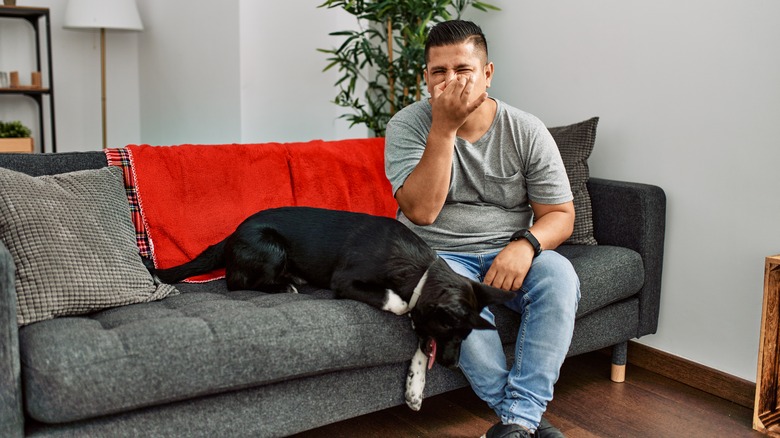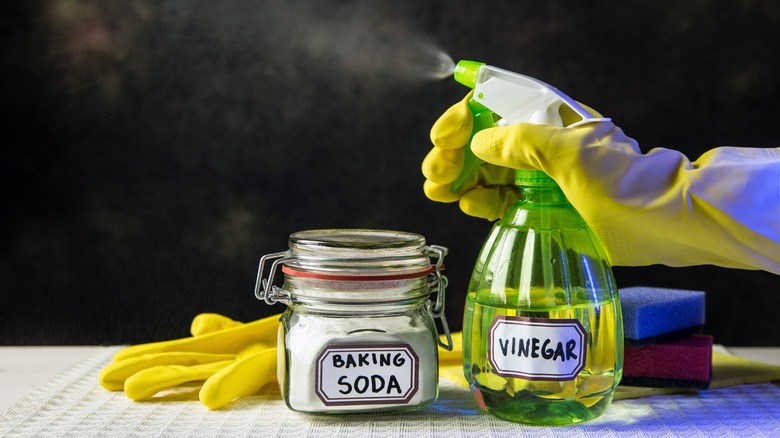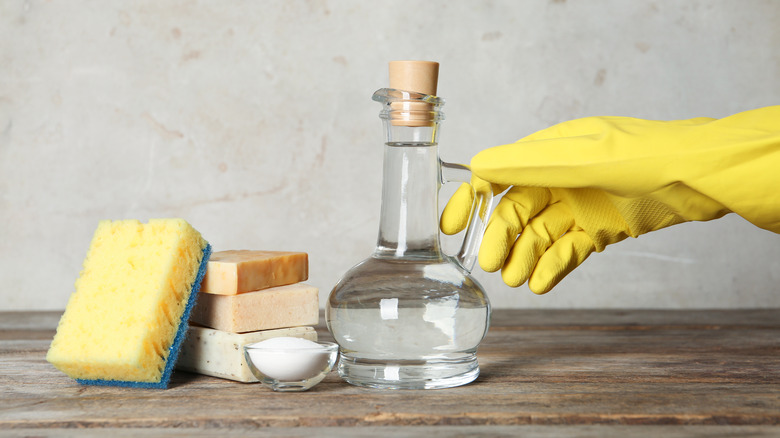If Your House Smells Like Skunk, Two Handy Household Staples Will Do The Trick
No matter whether you live in the city, suburbs, or the country, chances are you're quite familiar with the sights and smells of a skunk. These unwanted skunks can make a habit of wandering into your yard while searching for food, and there's no doubting their presence as you can follow your nose to their tell-tale smelly warning sign. Most of us will never know what it's like to be sprayed by this truly unique critter; however, if you're a pet owner, there's a very real chance that your furry friend may have an unlucky encounter with a skunk and bring that funk to your front door. The oily, musty, and sulfuric smell is distinct and has a habit of sticking around for a while if left untreated. Luckily, with the use of a few common household ingredients, like vinegar and baking soda, you can easily rid your home of any skunky odors.
The pungent scent from a skunk has a tendency to linger and settle into fabrics around the home. That's why if you or your pet have been sprayed, then you need to clean as soon as possible so that the smell doesn't cling to the rest of your residence. If a skunk has sprayed in close proximity to your property, then opening your windows and running all of the fans you have could be enough to dissipate the smell. However, if the smell is inside the home, then there are a few quick stink-reducing remedies to try.
Eliminate the skunk smell with vinegar and baking soda
To ensure that the skunk stink does not settle into the fabrics of your furniture or carpet or remain on any other surface around your home, you can utilize the cleaning powers of vinegar and baking soda. To clean your home after a skunk spray, use equal parts white vinegar to water and place in a spray bottle. Then spritz the mixture onto your carpet, curtains, and furniture as well as clean any surfaces around the home. The scent of vinegar will dissipate after a while and hopefully take the skunk smell with it. Another way to fend off the stink from a skunk is by leaving bowls of pure vinegar around the home. These bowls act as little odor eaters from room to room. For safety's sake, make sure to keep the vinegar out of reach of children and animals so that they don't mistake it for a drink of water.
Baking soda is also effective in the fight against skunk spray. Sodium bicarbonate is the perfect ingredient to use to help eliminate bad smells. Simply sprinkle some baking soda around the home or outside of your property in the area that you feel is most effective. Leave it to settle in for several hours, then sweep or vacuum the powder and repeat if necessary. To get the smell off your clothes, soak them in baking soda and vinegar, then wash them in your washer.
How vinegar and baking soda help to get the stink out
If the unwanted smell of skunk spray is present in your home, there are definitely advantages to using vinegar and baking soda to rid your home of this problem. Unlike deodorizing sprays or air fresheners — which will only slightly mask the smell of skunk spray but may not actually get the stink out of your home — vinegar and baking soda can actually help to eliminate the stink molecules. Vinegar is an inexpensive, strong, natural cleaning agent that can break down pungent skunk oils and bacteria. In the same vein, because of the acidic nature of the skunk's smell, baking soda — or soda bicarbonate — is able to aid in neutralizing the pH. The baking soda will absorb and balance the odor so that the smell can eventually fade.
Even though these are both readily available and natural products, you want to make certain that they are out of reach of your pets when used around the home. Baking soda, in particular, can be perfect for eating odors; however, it should not be ingested by your dog or cat because it can be incredibly toxic if eaten. According to the American College of Veterinary Pharmacists, depending on the size of your pet, it can take as little as a tablespoon of baking soda to make your pet ill. So it's best to use this cleaning method when your pet is in a safe area, either inside or outside of your home.


